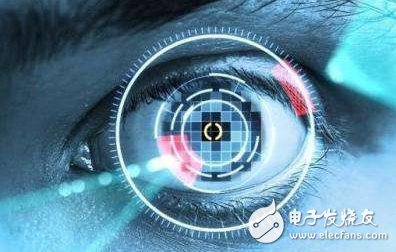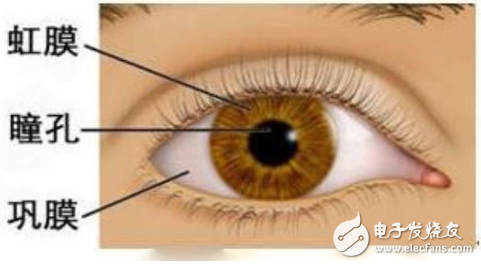Is iris recognition harmful to the eyes?
Iris recognition technology is based on the iris in the eye for identification, applied to security equipment (such as access control, etc.), and places with high security requirements. The structure of the human eye consists of the sclera, iris, pupillary lens, retina and the like. The iris is an annular portion between the black pupil and the white sclera that contains many detailed features of interlaced spots, filaments, crowns, stripes, crypts, and the like. Moreover, after the iris is formed in the fetal development stage, it will remain unchanged throughout the life course. These characteristics determine the uniqueness of the iris characteristics and also determine the uniqueness of the identity. Therefore, the iris feature of the eye can be used as an identification object for each person. For example, in Hollywood blockbusters, by scanning the eye retina to open a cool room or a safe scene, everyone must remember it! The use of iris recognition technology provides a high level of security for sites that require a high degree of confidentiality. Iris recognition technology is a kind of human biometric technology. The appearance of the human eye consists of three parts: the sclera, the iris, and the pupil. The sclera is the white part of the periphery of the eyeball, which accounts for about 30% of the total area; the center of the eye is the pupil part, which accounts for about 5%; the iris is located between the sclera and the pupil, and contains the most abundant texture information, accounting for 65%. Appearance, composed of many glandular fossa, wrinkles, pigment spots, etc., is one of the most unique structures in the human body. The formation of the iris is determined by genetics, and the expression of the human body determines the shape, physiology, color and overall appearance of the iris. When humans develop for about eight months, the iris is basically developed to a sufficient size and enters a relatively stable period. The iris morphology can remain unchanged for decades, unless rare abnormalities, physical or mental trauma can cause changes in the appearance of the iris. On the other hand, the iris is externally visible, but at the same time belongs to the internal tissue, behind the cornea. To change the appearance of the iris requires very fine surgery and the risk of visual impairment. The uniqueness, stability and unchangeable nature of the iris are the material basis for the identity of the iris. Among all biometric technologies, including fingerprints, iris recognition is one of the most convenient and accurate for current applications. Iris recognition technology is widely regarded as the most promising biometric authentication technology in the 21st century. Future applications in security, defense, e-commerce and other fields will inevitably focus on iris recognition technology. This trend has gradually emerged in various applications around the world, and the market application prospects are very broad. Iris recognition research institutions mainly include Iridian, Iriteck in the United States, Jiris in South Korea, Zhongke Hongba in Beijing, Xianghong in Beijing, and Panasonic in Japan. Iridian has mastered the iris recognition core algorithm and is currently the world's largest provider of professional iris recognition technology and products. It cooperates with LG, Panasonic, OKI, NEC and other companies (such as IRISPASS®, BM-ET300, IG-H100®, etc.) ), providing iris recognition core algorithms in an authorized manner, and supporting partners to produce iris recognition systems. Iridian's core technologies include image processing protocol and data standard PrivateID®, recognition server KnoWho®, KnoWho® development tools and iris recognition cameras. In the past, China has not had its own core intellectual property rights in the field of iris recognition before 2000. After 10 years of continuous efforts, as of 2013, China has developed a production and development base for Beijing-based iris, and has developed it on the basis of years of research. The core algorithm of iris recognition has become one of the few units in the world that has mastered the core algorithm of iris recognition. It has proved that China's iris products are recognized in speed and equipment stability by using them in the harsh environment of mines. To solve the black face problem of miners, they are far better than foreign iris products. As the first research base to start the research on iris recognition mechanism in China, the iris recognition biometric detection technology with independent intellectual property rights researched by the State Key Laboratory of Pattern Recognition of Chinese Academy of Sciences not only fills the gap in the international field of Chinese living iris recognition technology, but also It is comparable to the mainstream algorithms in the world. In 2005, the laboratory's iris recognition research achievements won the "National Science and Technology Invention Second Prize". In September 2006, the National Key Laboratory of Pattern Recognition, as the authority of China's iris recognition technology, participated in the Biometric ConsorTIum Conference and 2006 Biometrics Technology experiment, the speed of its iris recognition algorithm. And precision has been recognized by international counterparts. In addition, the iris image database of the State Key Laboratory of Pattern Recognition has become the largest iris shared library in the world. More than 2,000 research institutions in 70 countries and regions have applied for it, including more than 1,500 foreign institutions. The iris is a fabric-like ring in the pupil of the eye. Each iris contains a unique structure based on features such as crowns, crystals, filaments, spots, structures, pits, rays, wrinkles, and stripes. It is said that no two irises are the same. Iris recognition is to determine the identity of people by comparing the similarities between iris image features. The process of iris recognition technology generally involves the following four steps: 1 . Iris image acquisition The entire eye of the person is photographed using a specific camera device, and the captured image is transmitted to the image pre-processing software of the iris recognition system. 2. Image preprocessing The acquired iris image is processed as follows to satisfy the requirement of extracting iris features. Iris Positioning: Determines the position of the inner, outer, and quadratic curves in the image. The inner circle is the boundary between the iris and the pupil, the outer circle is the boundary between the iris and the sclera, and the quadratic curve is the boundary between the iris and the upper and lower eyelids. Iris image normalization: Adjust the iris size in the image to a fixed size set by the recognition system. Image enhancement: For normalized images, brightness, contrast, and smoothness are processed to improve the recognition rate of iris information in the image. 3. Feature extraction The feature points required for iris recognition are extracted from the iris image by a specific algorithm and encoded. 4. Feature matching The feature code extracted by the feature is matched with the iris image feature code in the database one by one to determine whether it is the same iris, thereby achieving the purpose of identity recognition. Recently, the Gome mobile phone was launched, and this mobile phone that received the international design if award was equipped with iris recognition technology. However, this is not the first mobile phone equipped with iris recognition. Glory Magic has a front and rear dual camera design, of which the rear is still 12 million pixels, the front lens will increase the iris recognition function. The official Weibo also promoted his security technology. First of all, what is the science of the iris? The structure of the human eye consists of the sclera, iris, pupillary lens, retina and the like. The iris is an annular portion between the black pupil and the white sclera that contains many detailed features of interlaced spots, filaments, crowns, stripes, crypts, and the like. At the same time, after the iris is formed in the fetal development stage, it will remain unchanged throughout the life course. This is somewhat similar to fingerprints, but it is safer than fingerprints. These special features determine the uniqueness of the iris characteristics and also determine the uniqueness and security of the identity. Therefore, iris recognition technology using iris as a recognition object has emerged to improve personal information security. In addition, when a person dies, the pupil will naturally enlarge, causing the iris to disappear, so only the living body can be identified by the iris only, and since the iris is a biological feature, it has the characteristics of life and life, and the eyes on the photo or video cannot be unlocked. . If iris recognition is used, it is necessary for the human eye to face the iris recognition hundreds of times a day. So maybe the question you care about most is, does iris recognition hurt our eyes? the answer is negative. The iris is illuminated by a certain wavelength of infrared light (generally between 700-900 nm), which generally presents a radial structure from the inside to the outside, containing many intertwined shapes resembling spots, stripes, crypts, etc. structure. Usually, we refer to these subtle features as texture features of the iris. The near-infrared light source used in iris recognition technology, the light intensity of the eye, only 1/10 of the light intensity specified by the IEC 62471 biosafety test standard, far below the safety threshold, will not cause eye damage. The radiation used for 100,000 times is much less than the radiation intensity of the phone for 1 minute. The light intensity is similar to natural light. At present, Rainbow technology is far higher than international safety standards. You can find out. Variable Frequency AC Power Supplies The VFP series AC Power Supplies are high precision, high efficiency, low THD adjustable AC power supplies that converts the input mains power through AC→DC→AC conversion, and gives a pure sine wave AC output with adjustable voltage & frequency within a certain range. Also known as Variable Frequency AC Power Source.
Variable Frequency AC Power Supplies, AC Variable Frequency Power Supplies, Variable Frequency AC Power Sources, Variable Frequency Power Supplies, Variable Frequency Power Sources Yangzhou IdealTek Electronics Co., Ltd. , https://www.idealtekpower.com









According to the difference in the number of output phases, it can be divided into single-phase and three-phase AC power supplies.
The output power of single-phase adjustable AC power supply ranges from 500VA to 200KVA, the output power of three-phase adjustable AC power supply ranges from 3KVA to 600KVA, the output voltage is divided into 0 ~ 150Vac, 150 ~ 300Vac, and the output frequency is adjustable from 45Hz to 70Hz with 50/60Hz fixed frequency output.
Through the friendly operation panel, you can read the output data such as output voltage, output current, output power, power factor, etc., providing accurate data records for your test, and can add RS485 interfaces as standard, following the MODBUS-RTU international communication protocol, which can realize remote control and operating status monitoring of the power supplies.
This series of adjustable AC Power Supplies have comprehensive protection functions, such as: over voltage, over current, over temperature and short circuit protections, which can protect the AC power supplies and DUT from damages. At present, it is mainly used for Various electrical appliance manufacturers conduct grid simulation tests on electrical appliances according to the voltage/frequency requirements of different countries. Imported electrical appliances are used for the domestic demand for variable voltage and frequency conversion, as well as various AC motors and AC transformers.